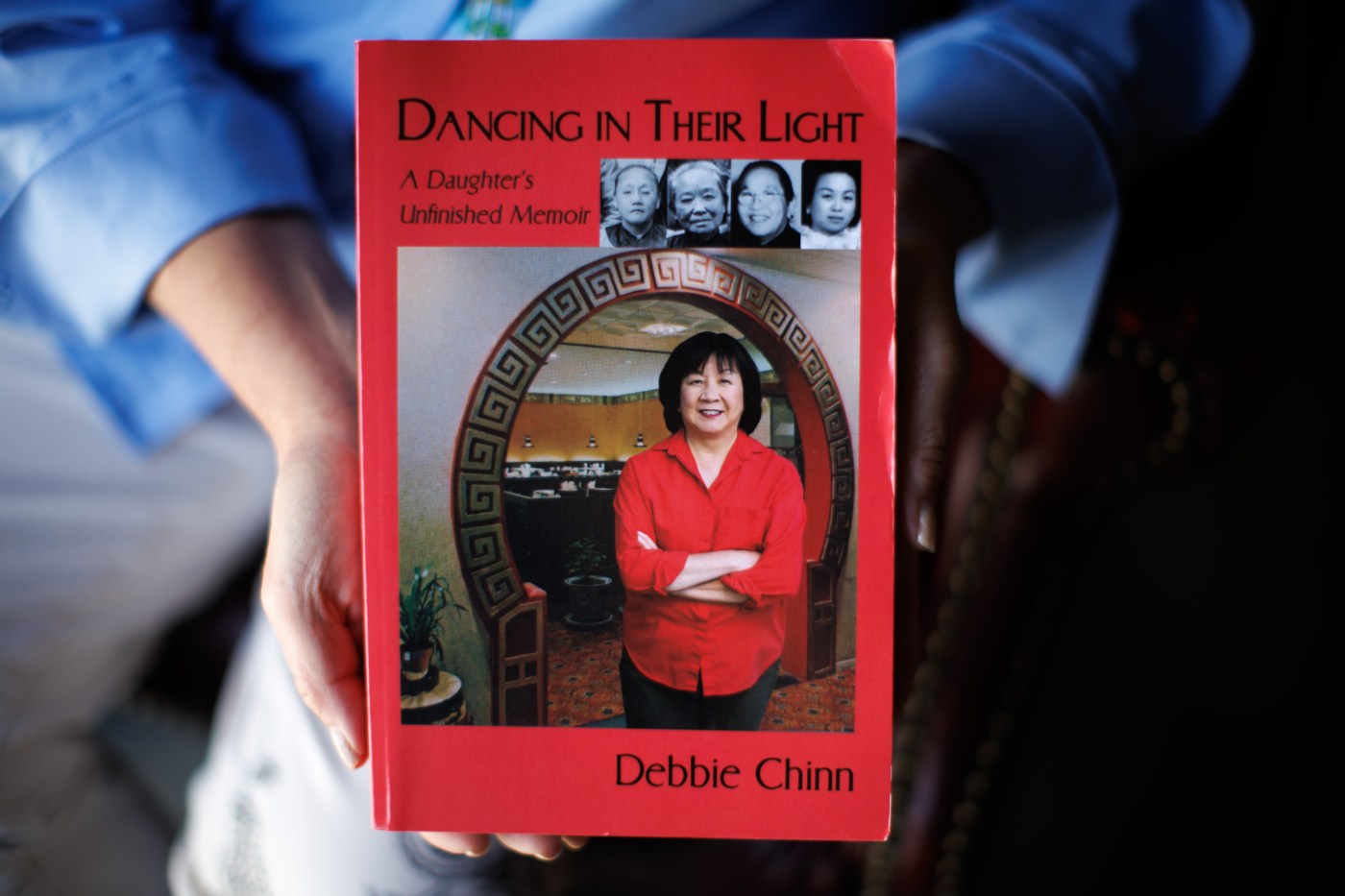Debbie Chinn always knew she had material for an engaging memoir about her family’s immigrant experience. The veteran Bay Area arts leader and executive director for TheatreWorks SiliconValley grew up working at the House of Mah Jong, her parent’s popular Chinese restaurant on Long Island in the 1960s and ’70s.
As Chinn recounts in “Dancing in Their Light,” her first job was selling cigarettes from a glass case — when she was 3. Pretty soon, Chinn was helping the bartender prep garnishes for “Mad Men”-era cocktails and working with kitchen staff to prep snow peas and wrap seasoned ground pork into wontons. At age 6, she escorted diners to their tables, and as a teenager, she danced hula and even performed in a Samoan knife routine, after her entrepreneurial father introduced a Polynesian-themed floor show to keep up with the tiki bar trend.
Author Debbie Chinn at TheatreWorks’ headquarters in Redwood City, Calif., on Friday, May 4, 2024. (Dai Sugano/Bay Area News Group)
Now, Chinn is adapting her 2022 memoir into a streaming series, and it’s easy to imagine a director like Jon M. Chu, of “Crazy Rich Asians” fame, perhaps, finding rich source material for sweet cinematic moments of a young girl swept up in the hustle and bustle of restaurant life in a bygone era.
Plenty of colorful characters dined at the restaurant: New York-area politicos, church officials and union leaders, as well as the occasional mobster and celebrities, including Elizabeth Taylor and Richard Burton stopping in for “refreshments” on their way to the Hamptons. Chinn’s descriptions of the Cantonese dishes served at the restaurant also are worthy of food-movie treatment.
But Chinn says she had a larger purpose in writing her memoir and in hoping her story makes it to the small screen. Starting in 2017, she grew disturbed by the surge in anti-immigration and anti-Asian discourse in America. She was spat upon in downtown San Francisco during the pandemic and told to “go back where you came from.”
She wants to illuminate the resilience of immigrants like her parents, who experienced “unimaginable horror and tragedy” before and during their journey to the United States.
“I wanted to talk about my family of immigrants who came to this country and who contributed so much to the United States,” she said. “There was a time when we were not the enemy.”
“Dancing in the Light” actually starts in China, where Chinn delves into her maternal lineage. Her great-great grandmother, Mary, was adopted by American Baptist missionaries as a young child, after her mother died during the Taiping Rebellion in the mid-1800s. Mary’s descendants prospered in business, with Chinn’s maternal grandparents, Frank and Kate Kwoh, settling in the coastal city of Qingdao in the 1930s to rear their eight children.
But their good life fell apart with the brutal Japanese invasion in 1937. The family was scattered, with some of Chinn’s mother Nellie’s siblings making their way to America. During her teen years, Nellie and her younger sisters endured near-starvation and the constant fear of rape, arrest or even worse by hiding out in a local Catholic school run by nuns. They kept up their morale by singing and telling each other stories, and hearing about that experience taught Chinn the power of art.
Related Articles
Real-life drama upends San Jose musical’s opening night
Review: ‘Assassins’ — yes, ‘Assassins’ — gets spirited production in San Jose
East Bay theatre company to host benefit concert after devastating fire
7 amazing Bay Area things to do this weekend
The Grateful Dead and Francis Ford Coppola are among the newest Kennedy Center Honors recipients
“All they had was what was in their hearts,” Chinn said. “Art is healing. It takes you into another space, out of misery, of war and fear and into a psychological place that’s safe.”
Chinn’s father was 15 when he came to the United States in 1930, entering the United States “at great risk,” she said. At the time, the Chinese Exclusion Act was in full force, the result of backlash against immigrants accused of taking jobs from white workers. Peter Chinn eventually earned a degree in chemistry from New York University and an MBA from Harvard and became a proud U.S. citizen, volunteering for the Marines and assigned to intelligence in China following the Japanese surrender. That’s where he met and married Nellie and helped her, her mother and sisters leave China before the Communist takeover.
Over the next decade, Peter and Nellie Chinn joined the ranks of upwardly mobile, post-war American couples. They started a family and made their way to Long Island, where Peter found an old potato barn in the rapidly growing suburb of Syosset, transforming it into the House of Mah Jong.
Peter and Nellie Chinn became one of the first Asian couples to buy a home in the area, wanting their children to attend its excellent schools. But Chinn admits she didn’t enjoy the typical childhood, as she and her two siblings “lived” at the restaurant.
“I’d come in after school and sit at the bar,” Chinn said. “Customers would ask, ‘How was your day?’ I’d ask back, ‘How was your day? What do you do?’ I learned the art of small talk and listening, essential skills which I have used when developing business and community relationships.”
Chinn also witnessed the “deep sense of empathy and compassion” her parents brought to running their restaurant and managing employees. They inspired loyalty by sponsoring cooks from China and providing staff with good salaries, so they could send money back home. “They remember what it was like to be ostracized and left out or starving and being erased,” Chinn said.
Chinn also emphasized the ways her parents gave back to their community, having food delivered to the local hospital and inviting customers to join in a Chinese New Year’s celebration at the restaurant. With its red and gold decor and white tablecloths, the House of Mah Jong became a special-occasion restaurant for locals. Before Chinn even thought about writing a memoir, she learned about the imprint the restaurant left on Syosset’s cultural memory. After she shared photos of the restaurant in Facebook groups focused on her hometown, scores of people jumped online to share memories about the dishes they ate, waiters they liked, birthdays they celebrated.
Chinn also heard from others who said she had a “universal story” to tell about immigrants and why hostility to them is counterproductive. “Immigrants really do wonderful things for this country,” she said. “They always have.”












